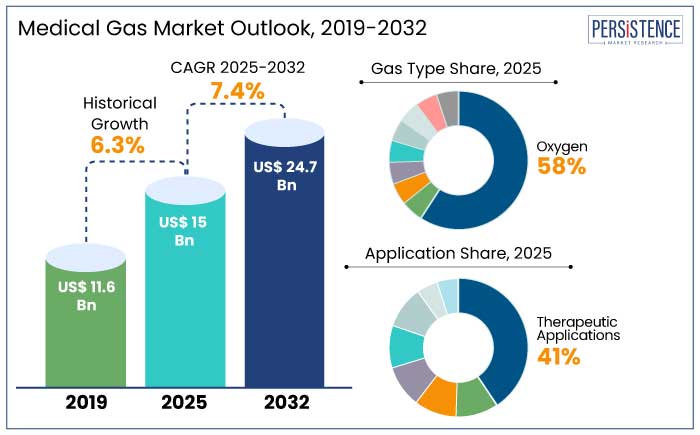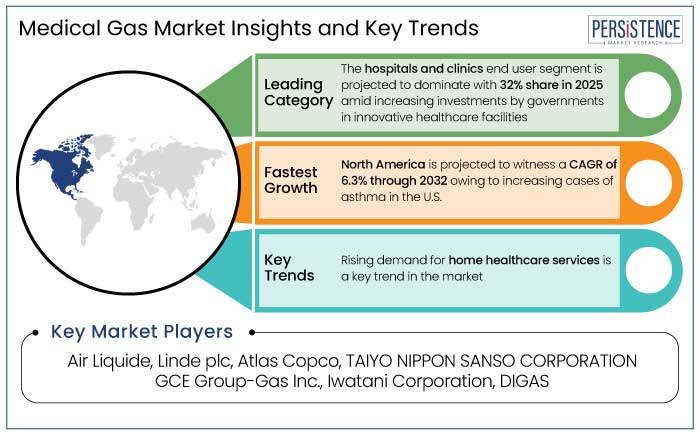Industry: Healthcare
Published Date: January-2025
Format: PPT*, PDF, EXCEL
Delivery Timelines: Contact Sales
Number of Pages: 189
Report ID: PMRREP33119
The global medical gas market is estimated to increase from US$ 15 Bn in 2025 to US$ 24.7 Bn by 2032. The market is projected to record a CAGR of 7.4% during the forecast period from 2025 to 2032.
Rising incidence of these respiratory conditions has increased the need for medical gases, particularly oxygen, for therapeutic purposes. Nearly 90% of COPD deaths in individuals under 70 years of age occur in Low- and Middle-Income Countries (LMICs), highlighting a critical need for medical gas supplies in these regions. In 2019, there were around 212.3 million prevalent cases of COPD globally, accounting for 3.3 million deaths and 74.4 million disability-adjusted life years (DALYs).

Key Highlights of the Market
|
Market Attributes |
Key Insights |
|
Medical Gas Market Size (2025E) |
US$ 15 Bn |
|
Projected Market Value (2032F) |
US$ 24.7 Bn |
|
Global Market Growth Rate (CAGR 2025 to 2032) |
7.4% |
|
Historical Market Growth Rate (CAGR 2018 to 2022) |
6.3% |
North America is anticipated to hold a share of 38% in 2025 in the medical gas industry. It is driven by increasing use of these gases in treating respiratory diseases, including COPD and asthma.
Growing incidence of COPD, asthma, cardiovascular diseases, and lifestyle-related health issues is set to further fuel demand for medical gases in the U.S. over the forecast period. The U.S. benefits from novel healthcare infrastructure, including state-of-the-art intensive care units, a well-established healthcare market, and a rapidly growing elderly population, all of which contribute to its market leadership.
Oxygen dominates the medical gas industry due to its critical role in treating respiratory conditions and supporting patient recovery. Its widespread use spans a variety of applications, including emergency oxygen therapy, anesthesia, and chronic disease management. The segment is estimated to hold a share of 58% in 2025.
Increased prevalence of Chronic Respiratory Diseases (CRDs) like COPD, asthma, and pulmonary hypertension has further fueled demand. The COVID-19 pandemic significantly raised the need for oxygen therapy as several patients required respiratory support in hospitals and home care environments.
Government investments in healthcare infrastructure, especially in emerging markets, have been instrumental in boosting the demand for oxygen in hospitals and home use. Demand for portable oxygen concentrators and on-site oxygen generation systems is rising as healthcare facilities seek to provide continuous, cost-effective oxygen supply solutions.
The therapeutic applications segment is projected to account for around 41% of the total market share in 2025. The segment's dominance highlights its critical role in healthcare systems globally. Key gases such as oxygen and nitrous oxide are essential for therapeutic purposes, driving consistent demand.
Chronic respiratory conditions such as Chronic Obstructive Pulmonary Disease (COPD) and asthma are rising globally. COPD affected over 212.3 million people worldwide in 2019, and asthma remains a prevalent condition, with millions of cases globally. Such conditions necessitate the continuous use of medical oxygen for oxygen therapy, making it the cornerstone of therapeutic applications.
The medical gas market is integral to healthcare systems worldwide. It provides vital gases like oxygen, nitrogen, carbon dioxide, and helium for various medical applications, including respiratory support, anesthesia, and cryotherapy.
The market has been shaped by increasing demand driven by rising incidence of Chronic Respiratory Diseases (CRDs) such as COPD, asthma, and pulmonary hypertension, which have spiked with pollution levels and unhealthy lifestyles. A key trend driving the market is the rising adoption of home healthcare solutions. The trend was accelerated considerably by the COVID-19 pandemic, which increased the need for oxygen in home care settings and hospitals for severe respiratory conditions.
As countries invest more in healthcare infrastructure, particularly in emerging markets, demand for medical gases is set to surge. Governments have established oxygen plants and ensured better supply systems, particularly in remote and underserved regions.
Developments in gas generation technologies, such as on-site oxygen generation, are also reshaping the market. Such innovations offer more cost-effective and efficient alternatives to traditional gas cylinders, which are set to improve accessibility and reduce dependency on external suppliers.

From 2019 to 2023, the global medical gas market experienced steady growth at a CAGR of 6.3%. Government investments in healthcare infrastructure, particularly in oxygen generation plants and medical gas supply chains, contributed to market development. This period also saw greater adoption of unique gas delivery systems and Portable Oxygen Concentrators (POCs) in emerging markets.
Over the forecast period, the market is set to continue its upward trajectory, with a projected CAGR of 7.2% driven by the ongoing need for respiratory support and medical gas solutions. Increasing incidence of CRDs, coupled with the continued rise in home healthcare and the development of unique gas technologies, presents a favorable growth landscape.
Surging Prevalence of Chronic Respiratory Diseases Worldwide
Growth of the market is primarily attributed to the rising number of Chronic Respiratory Diseases (CRDs) patients worldwide. Increasing number of CRD cases is attributed to the rising pollution and unhealthy lifestyles.
The World Health Organization (WHO) stated that more than 3 billion people die because of CRDs, including asthma, occupational lung diseases, and pulmonary hypertension. Use of oxygen and other mixtures like lung gas mixtures is used to treat multiple respiratory disorders.
Rising Government Support for Smooth Oxygen Supply
Government initiatives worldwide have significantly bolstered the medical gas industry, crucial in enhancing healthcare accessibility and infrastructure. In recent years, various countries have made substantial investments to ensure a steady and reliable supply of medical gases, particularly oxygen, which has become a lifeline in critical care. For instance,
Several governments provide subsidies and grants to healthcare providers to extend medical gas pipeline systems, especially in rural and underserved areas. Such efforts enhance the availability of oxygen therapy and other critical gases and strengthen the overall healthcare infrastructure.
Easy Availability of Alternative Therapies like Nebulizers
Alternative oxygen and other gas generators are limiting the market's growth. At the peak of the pandemic, when oxygen supplies were limited, people started looking for other options for oxygen, like small nebulizers that are helpful for respiratory disorders.
Lower government spending on total healthcare also limits growth of the medical gas market, declining sales in developing nations. The healthcare industry's fall in multiple regions, especially post COVID-19, has decreased demand for medical gas.
Rapid Shift toward Home Healthcare Solutions
The global medical gas market is poised for substantial growth, driven by the rising prevalence of CRDs and the sustained demand for medical oxygen in the post-COVID-19 era. Increasing need for respiratory support, particularly in homecare settings, has created a booming market for portable oxygen concentrators and novel gas delivery systems.
To address the rising demand, governments worldwide invest in developing oxygen generation plants, especially in remote and underserved regions, ensuring equitable access to essential medical gases. Emerging markets in Asia Pacific and Africa offer significant untapped potential as improvements in healthcare infrastructure and accessibility continue to broaden.
Innovations in customized gas mixtures and innovative solutions provide new growth avenues for medical gas providers, enabling them to cater to diverse therapeutic and diagnostic needs. As the focus on respiratory care and healthcare infrastructure development intensifies, the medical gas industry is set to witness robust growth in the next ten years.
The global medical gas industry is moderately consolidated, with a few key players holding significant shares. Leading companies such as Air Liquide, Linde Group, and Atlas Copco employ various strategies to strengthen their competitive positions.
Collaborations and partnerships are commonly pursued to extend geographic reach and enhance service portfolios. For instance, acquisitions, such as Air Liquide’s purchase of Sasol's oxygen production facility, bolster production capacities and reinforce market presence.
Product innovation remains another key focus, with companies launching novel medical gas systems to address evolving healthcare needs. These strategic moves collectively drive market growth and solidify the competitive landscape.
Recent Industry Developments
|
Attributes |
Details |
|
Forecast Period |
2025 to 2032 |
|
Historical Data Available for |
2019 to 2023 |
|
Market Analysis |
US$ Billion for Value |
|
Key Country Covered |
|
|
Key Market Segments Covered |
|
|
Key Companies Profiled |
|
|
Report Coverage |
|
|
Customization & Pricing |
Available upon request |
By Gas Type
By Application
By End User
By Region
To know more about delivery timeline for this report Contact Sales

The market is estimated to reach US$ 15 Bn in 2025.
Increasing cases of chronic respiratory diseases, development of healthcare infrastructure, and high home healthcare demand are set to propel the industry.
Air Liquide, Linde plc, Atlas Copc, and GCE Group-Gas Inc. are few of the leading players.
The industry is projected to record a CAGR of 7.4% from 2025 to 2032.
Emergence of portable oxygen concentrators for home healthcare presents a prominent opportunity in the industry.